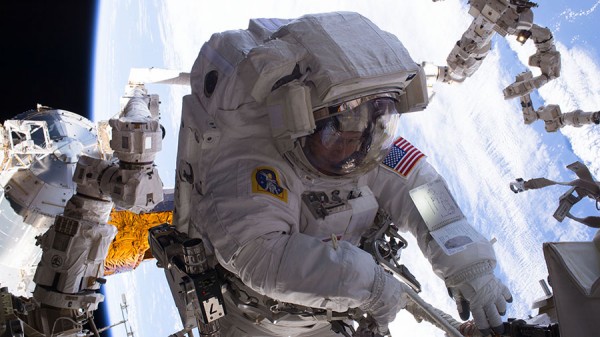By Ana Verayo, | January 16, 2017

Astronaut Peggy Whitson is pictured Jan. 6, 2017, during the first of two spacewalks to upgrade power systems on the International Space Station. (NASA)
Astronauts at the International Space Station successfully completed the installation of new power lines on the International Space Station (ISS) on Friday, January 13.
Like Us on Facebook
Two astronauts embarked on a spacewalk. They completed all their objectives and even had extra time to accomplish some other tasks. NASA Space Station Commander Shane Kimborough and European Space Agency's Thomas Pesquet headed out at 6:22 a.m. EST.
This spacewalk was initially slated to last for 6.5 hours, but the duo completed all their tasks ahead of schedule, finishing all their objectives at 3.5 hours.
Kimborough had performed a spacewalk one week earlier with NASA astronaut Peggy Whitson, making this his fourth spacewalk. This is Pesquet's first spacewalk.
This spacewalk mission is the second phase of the ISS' power upgrade installation process which began in December. During these spacewalks, astronauts were able to replace nine old nickel batteries with six new lithium ion batteries.
Before these spacewalks, the robotic arm "Dextre" transferred these new batteries from the Japanese HTV-6 cargo re-supply spacecraft that arrived in December. The robotic arm placed them into their slots so that the astronauts can link them to the power grid of the ISS.
This spacewalk involved the installation of new batteries and wiring them to electrical connections with special adapter plates. The first spacewalk two weeks ago involved installing the first three if the ion batteries. In this second spacewalk, the astronauts completed the installation of the last three lithium ion batteries and adapter plates.
The old nickel batteries will be transported by Dextre back to the cargo vehicle. When the HTV-6 cargo vehicle departs the ISS, the craft along with the batteries will burn up upon re-entry into the Earth's atmosphere.
These new batteries will be charged by the space station's solar panels. The new lithium ion ones will be more efficient in providing power for the ISS.
-
Use of Coronavirus Pandemic Drones Raises Privacy Concerns: Drones Spread Fear, Local Officials Say

-
Coronavirus Hampers The Delivery Of Lockheed Martin F-35 Stealth Fighters For 2020

-
Instagram Speeds Up Plans to Add Account Memorialization Feature Due to COVID-19 Deaths

-
NASA: Perseverance Plans to Bring 'Mars Rock' to Earth in 2031

-
600 Dead And 3,000 In The Hospital as Iranians Believed Drinking High-Concentrations of Alcohol Can Cure The Coronavirus

-
600 Dead And 3,000 In The Hospital as Iranians Believed Drinking High-Concentrations of Alcohol Can Cure The Coronavirus

-
COVID-19: Doctors, Nurses Use Virtual Reality to Learn New Skills in Treating Coronavirus Patients







